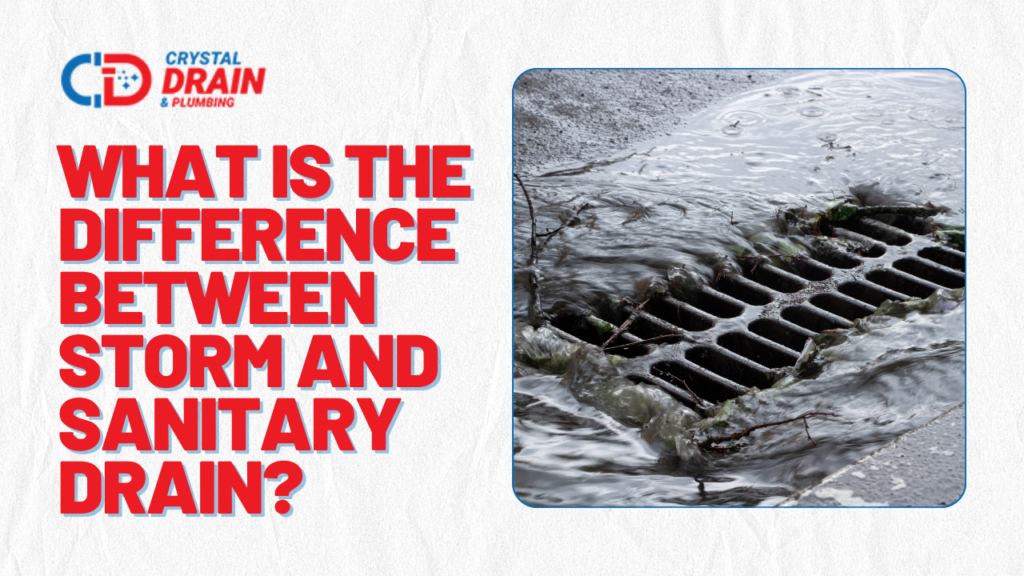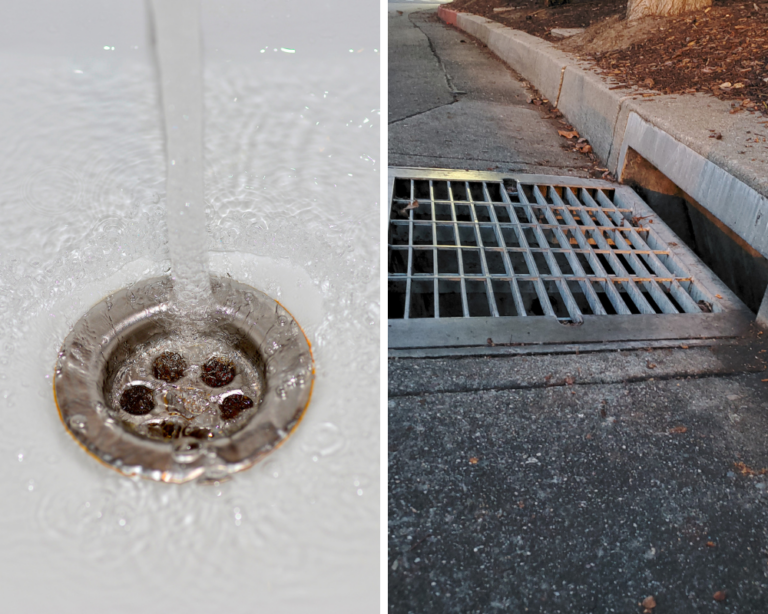- Last updated: January 14, 2025
What’s the Difference Between a Storm Drain and a Sanitary Drain?

Drains are an essential part of your home’s infrastructure, but they can be confusing, especially if you’re not familiar with how they work. One of the most common questions we get is: What’s the difference between a storm drain system and a sanitary drain system? These two types of systems have different purposes, and understanding them is important for proper maintenance and plumbing care.
Key Takeaways
- Purpose of Systems: Sanitary drains handle wastewater from household activities, while storm drains manage rainwater and melted snow.
- Water Treatment: Sanitary drains require water treatment due to contamination, whereas storm drains do not, as they carry clean water.
- System Location: Sanitary drains are found inside buildings for managing used water, while storm drains are located outside, directing rainwater away from streets and open areas.
- Combined Systems: Older combined drainage systems mix both types of water, but modern plumbing codes separate them to avoid unnecessary treatment of clean stormwater.
- Professional Assistance: Plumbers can identify and resolve issues related to storm, sanitary, or combined drainage systems, ensuring proper maintenance and function.
What is a Sanitary Drain System?
A sanitary drain system is designed to handle wastewater from your home—specifically, contaminated water that requires treatment. This water typically comes from sources like:
- Bathrooms (toilets, showers, sinks)
- Kitchen sinks
- Washing machines
Essentially, any water that has been used for washing, flushing, or cleaning will go into the sanitary drain system. It then travels through pipes to
What is a Storm Drain System?
On the other hand, a storm drain system is built to carry rainwater and melted snow—water that falls from the sky or runs off the ground. Unlike wastewater, this water is not contaminated by human use, so it doesn’t need treatment. Storm drains simply direct this runoff to nearby water sources, like rivers or lakes, without any need for purification.

Key Differences Between Sanitary and Storm Drains
- Water Source:
- Sanitary drains carry water from household activities (showers, toilets, dishwashers, etc.).
- Storm drains collect water from the ground, like rainwater and melted snow.
- Treatment:
- Sanitary drains need to send water to treatment plants because it’s contaminated.
- Storm drains don’t require treatment since the water is clean.
- Location:
- Sanitary drains are usually found in residential homes and commercial buildings, where they handle water from appliances and plumbing fixtures.
- Storm drains are typically found outside, draining water from streets, sidewalks, and open areas.
What Happens When Both Systems Are Combined?
In some cities, you may find a combined system. This happens when the storm and sanitary systems are connected, so both wastewater and stormwater flow through the same pipes. While this was a common practice in older systems, it’s no longer allowed in most places due to modern plumbing codes, which separate the two types of water to avoid unnecessary treatment costs for clean stormwater.
Why the Separation Matters
Why is it so important to keep stormwater separate from wastewater? Simple: Stormwater doesn’t need to go through the expensive and energy-intensive treatment process that wastewater does. Keeping the two systems separate ensures that clean water isn’t treated unnecessarily, while contaminated water gets the full treatment it needs.
How Can a Plumber Help?
A licensed plumber can help you identify what kind of drainage system your home or property uses. If you’re experiencing a plumbing issue, they’ll be able to determine whether it’s related to your storm drain, sanitary drain, or a combined system and take the necessary steps to fix it.
FAQs About Drain Systems
Yes, storm drains can become clogged with debris such as leaves, dirt, and even trash. Regular cleaning and maintenance can help prevent blockages.
A bad odor could indicate a problem with your sanitary drain system, such as a clogged vent pipe or dried-out trap. A plumber can inspect and address the issue.
If you have a combined system, it’s important to ensure that it’s functioning correctly. A plumber can help inspect the system and make sure everything is draining properly.
Keep gutters and downspouts clear, and make sure there are no obstructions near the storm drain. You may also want to install a leaf guard or drain filter.
Grease and chemicals can clog pipes and contaminate the water. Always dispose of grease and harsh chemicals in the proper way—never down your drain!
